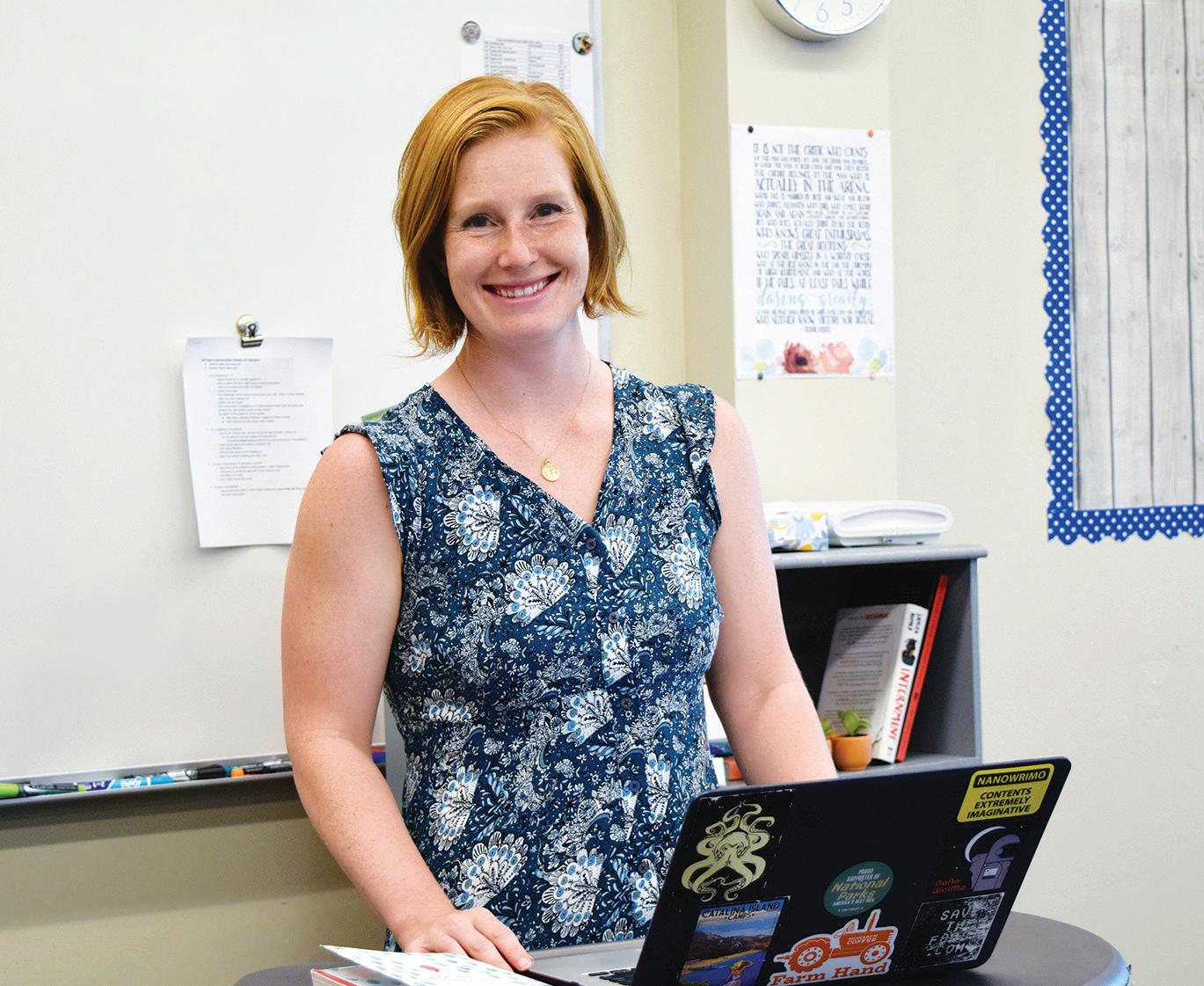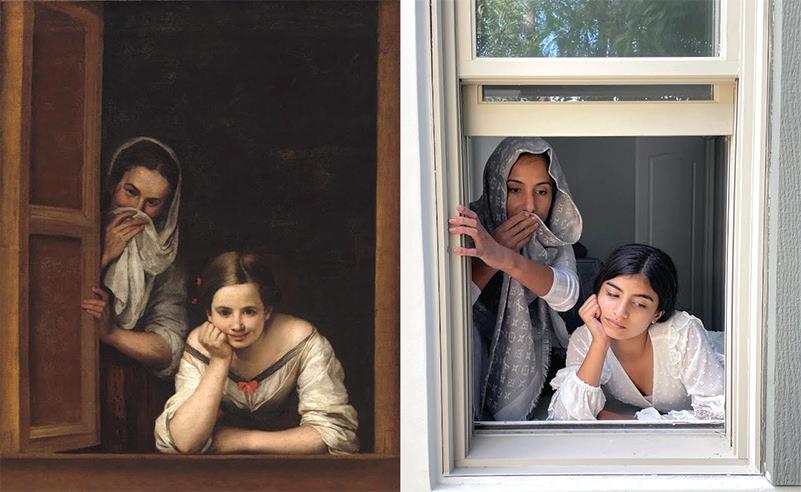
10 minute read
GROWING TOGETHER FROM DISTANCE LEARNING
Julie Alweheiby
Advertisement
When we began our Temporary Distance Learning Program (TDLP) at Pegasus, I relied on my 14 years of experience as an online college professor for the Coast Community College District to continue to deliver meaningful lessons at a distance. I was able to transition seamlessly and digitize most of my curriculum; however, I must admit that I was concerned about distance learning for middle school students, especially with learning a foreign language. I knew college students could handle it...but middle school students? I wasn’t so sure. However, I observed language learning happening in my classes each day. I saw motivation and drive. In distance learning, this is crucial in order for students to learn, regardless of age.
Shift In Student Needs
Pegasus has always taught with personalized learning, yet that teaching style feels amplified when teaching in person and distance learners in the class at the same time. It feels at times like a one-room schoolhouse from the 1800’s. What crosses a teacher’s mind is: How can I be everything to everyone? How can I teach writing concepts at the same time to students of different levels? How do I manage all of the lesson plans for several students? This feat seems impossible. However, just like a one-room schoolhouse from the 1800s, the hybrid model at Pegasus during the 2020-2021 school year brings both oncampus students and distance learning students of different levels and learning styles into the same classroom using various technology tools to cater to each individual student’s needs.
On any given day, Pegasus teachers are toggling simultaneously between distance learners and on-campus learners while engaging both types of students as they deliver instruction. Suraj S., a seventh-grade distance learner, shares his thoughts about our hybrid program, “The positives of screen time in school are that I get to see everybody in the class. It helps me stay more engaged. I really enjoy seeing my in-person peers, and it is easier to understand everything that is going on when I can see my class.” Comments like these show teachers we are meeting the needs of our students during these unprecedented times.
The Hybrid Model Promotes Independence
In our modern day “one-room schoolhouse” at Pegasus, students are more responsible for their education, while becoming entrepreneurial learners in the process. The entrepreneurial teacher is consistently looking for new ways to deliver engaging curriculum with tools and technology, while the entrepreneurial learner is consistently looking for ways to learn new things by trying out different technology tools.
In Spanish class, I intentionally assign distance learners with on-campus learners as partners to create skits in Spanish and act them out, so that both types of learners are actively engaged. The at-home learners are very clever and resourceful by adding backdrops to fit the location of the skit.
Students also are assigned a weekly discussion they post in Spanish using Padlet, a live, interactive community board where students post a response to a topic, upload a picture or video, and then comment in Spanish on other classmates’ posts. There, students in all cohorts can coexist and interact in online discussions. Typically, the most extroverted students can often dominate conversations, leading to fewer viewpoints being shared in discussions, but using tools such as Padlet gives everyone a voice and helps bridge the gap between online and on-campus learners.
Joy Sprimont, seventh-grade English teacher, also uses Padlet and Actively Learn to engage both students in class and at home. “I have found that self-paced assignments where I’ve mapped out the entire unit from beginning to end and presented to students in such a way that they can work through it at their own pace have worked well for all students. Everything is available to them at once, rather than the teacher leading the students through each activity day by day. Specifically, I created a Google slide deck that included steps for students to follow at their own pace. Digital platforms like Padlet and Actively Learn are a huge help right now!”
These innovative tools are creating more critical thinking opportunities for our students and shaping them into more independent learners as they become familiar with the new tools. Sixth-grade science teacher, Jamie Kunze-Thibeau, has an excellent point, “Some teachers are definitely having fewer students reach out for help. Students have to become more independent and responsible in regards to figuring things out because it is more difficult to ask a quick question. In the past, students could quickly ask questions during tutorial, and now they have to sign onto Zoom and if they are in class it is difficult in a quiet room to do so. I feel like students would rather figure it out on their own than Zoom with a teacher.”

All Screen Time Is Not Created Equal
Screens are at the center of almost all remote learning setups, but all screen time shouldn’t be generalized as negative or detrimental. Alix Gallagher, the director of strategic partnerships for Policy Analysis for California Education,
says, “Schools need to focus on designing days around what gives kids meaningful interaction and what fulfills their social needs.” She recommends a mixture of lessons that deliver information, like a video or lecture, plus activities for actively engaging with the lessons. Gallagher points out that anything that promotes children‘s socialization, like FaceTime with friends or a video conference with the teacher, can be beneficial. Activities in which students feel engaged are better than something completely passive, like watching YouTube, or even something somewhat interactive, like playing video games.
Dr. Laura Anthony, a psychologist with Children’s Hospital in Denver, Colorado says it’s unlikely that parents will be able to limit screen time during the pandemic and remote learning, let alone while they’re working from home. “Let go of the stress and guilt, as that’s going to do more damage to your child’s mental health than screens,” says Anthony. She emphasizes that different kinds of screen time aren’t the same. “Remote learning is not the same thing as watching TV, for example,” she observes. “Remote learning will happen at a developmentally-appropriate pace, is not passive the whole time, and is important for your child’s education and socialization.” When it comes to recommendations, Anthony highlights it’s important to try and spend some time outside and strive to do something fun every day. In the end, spending time outside is a great way to give the brain and eyes a break for teachers and students.
When asked about screen time, seventh grader Suraj S. responds, “I am still on screens when not in school. I watch the news with my parents, play Among Us with my friends, and watch TikTok. Although I don’t do all of these things in one day, they help me relax. I also FaceTime my friends a lot. Video games and FaceTime are pretty much the only ways for me to stay connected with my friends. I value social life, and I think that it is important to stay connected with my friends.”
Kaya W., another seventh-grade student, has similar thoughts, “I am still using FaceTime and Zoom to contact my friends. Sometimes, my friends and I will Zoom after school and do homework, but not working together unless it’s a group project. We have each other on screen to keep company, and every 30 minutes, we take a 5–10 minute ‘brain break’ and do a fun activity together, like taking personality quizzes.”
When planning lessons, teachers keep screen time in mind for both distance learners and in-person learners. There are some assignments where I intentionally do not use technology. For example, rather than having students complete an assignment using Kami, (a digital tool that converts any PDF file into a document that students can type on), I have students to print it out and write on it, thus reducing some screen time. Projects that students can work on without a computer include the seventh-grade “Living Pictures” project, where they recreated a painting or sculpture of a notable Spanish or Latin American artist.

The Teacher/ Student Relationship Amidst Distance Learning
Did teachers and students become closer over Zoom? Have we gotten to know our students better during distance learning? We can see a glimpse of private spaces at home and pets in the background, but we also see them less frequently. How do we teachers stay emotionally connected to students despite distance learning and social distancing? I asked a few teachers.
Kunze-Thibeau states, “While we can’t get as close physically, we are still able to have powerful conversations in a safe way. Just this week I was able to sit down one-on-one with several of my advisees and just chat. I have also Zoomed with students both during and outside of school hours. We communicate via email as well. I am still able to get to know my students and to help support them in the way that they need it most.” Nancy Wilder, eighth-grade English teacher adds, “I make a point to check in with my distance learners in Cohort C during tutorial. When they sign on to my tutorial Zoom, I like to see how they’re doing. Chrissy Bridges and Christine Lopez hosted an online bingo game at lunch, and that social time allowed the distance learners to interact with the on-campus learners.”
The relationship between the teachers and distance learners can be very positive, but it does require some creativity. Knowing how to be present for the students and being able to adapt lessons based on students’ nods, smiles, questioning stares of confusion, or smiles of recognition during class are all ways we communicate through a screen. Pegasus teachers understand each and every one of their students’ abilities, strengths and shortcomings, whether they are sitting in the classroom or are learning in their homes. Once we are all on Zoom together as a cohort, we are one. I can then put everyone in breakout rooms in small groups to have our conversations in Spanish.
For distance learning, teachers may not be able to see everyone on the Clever Touch screen at once, especially when sharing a screen or giving a lecture. I need to see all my students’ faces at some point during class. When students are quiet, calling out their name to let them know they are acknowledged just as students are in the classroom, helps to strengthen the bond between teachers and distance learners too. Sprimont stated, “We have started to get into a rhythm. I think we have found ways to include our distance learners in creative ways, and I have been so impressed by how resilient and adaptable all of our students are.”
Undoubtedly, this year has been a learning curve for teachers and students. What’s been clear about this shift in learning at a distance, is that embracing technology and these new ways of working and learning is no longer just dependent on teachers. Students also play an important role in distance learning, adapting to new technology as part of a successful education this year. Pegasus students and teachers have accomplished this and more. The concept of the “oneroom schoolhouse” where learning is personalized for each student, whether on campus or at a distance is evident, and we have made the seemingly impossible, very possible.
Julie Alweheiby is the seventh-grade Spanish teacher and mother of a seventhgrade son and 8-year-old boy and girl twins. She is always in search of new words and expressions in foreign languages and catching up on world events. Contact: jalweheiby@thepegasusschool.org
Living Pictures Project
Seventh-grade Spanish students recreated a painting or sculpture of a notable Spanish or Latin American artist. The images below highlight a few of these masterpieces.














